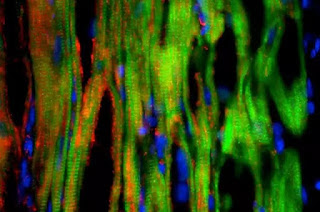It is possible to change fibroblasts -scar tissue cells into cardiomyocytes -heart muscle cells. Researchers used single cell RNA sequencing technology in combination with mathematical modeling and genetic and chemical approaches to delineate the step-by-step molecular changes that occur during cell fate conversion from fibroblast to cardiomyocyte. They reconstructed the routes a single cell could take in this process but also identified underlying molecular pathways and key regulators important for the transformation from one cell type to another.
Embryonic stem cells throughout human body gradually changes into a variety of highly specialized cell types, such as neurons, blood cells, and heart muscle cells. New discovery showed that it is possible to revert terminally differentiated somatic cells to a pluripotent state- cell that can self-produce and potentially turn into any kind of cell in the body. Researchers have also figured out how to convert one kind of differentiated somatic cell type into another without detouring through the pluripotent stage or the original progenitor stage. Such findings shifted the paradigm of cellular hierarchy and revolutionized stem cell research and the field of regenerative medicine.
Direct cardiac reprogramming, a promising approach for cardiac regeneration and disease modeling that direct conversion of cardiac non-myocytes into induced cardiomyocytes (iCMs) that closely resemble endogenous CMs. Like any reprogramming process, the many cells that are being reprogrammed don’t do so at the same time.
Cellular reprogramming is heterogeneous, which makes it difficult to study using traditional approaches.
Using microfluidic single-cell RNA sequencing techniques, addressed the two main issues of ‘asynchronous’ programming and heterogeneous cell populations. They analyzed global transcriptome changes during fate conversion from fibroblasts to iCMs.
Using mathematical algorithms, they identified molecularly distinct subpopulations of cells along the reprogramming pipeline.
After a heart attack, cardiac fibroblasts around the injured area are immediately activated and become highly proliferative but this proliferative capacity decreases over time. How to take advantage of the varied cell cycle status of fibroblasts over the progression of a heart attack and its aftermath would certainly broaden the application of cellular reprogramming for patients and optimize outcomes. The molecular features of subpopulations of fibroblasts were differentially suppressed during reprogramming, suggesting that the susceptibility of cells to be reprogrammed varies.
This susceptibility coincides with the timing of cardiomyocyte differentiation during heart development. The signatures in the intermediate populations that seem to appear earlier in heart development were more resistant to the alterations. This suggests that the recent epigenetic memories of cells might be more easily erased, and so the fibroblast subpopulations with such epigenetic features are more easily converted into cardiomyocytes. Adjusting epigenetic memories not just changing their current epigenetic status could be crucial for changing a cell fate for therapeutic value.
haleplushearty.blogspot.com


